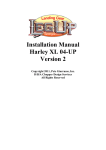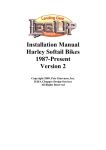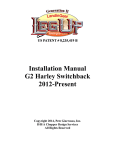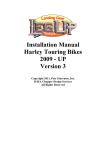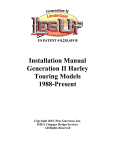Download Installation Manual Honda 750 Shadow Aero 04
Transcript
Installation Manual Honda 750 Shadow Aero 04-2011 Version 3 Copyright 2011, Pete Giarrusso, Inc. D/B/A Chopper Design Services All Rights Reserved 2 Table of Contents INTRODUCTION .................................................................................... 4 WARRANTY ............................................................................................ 5 INSTALLATION INSTRUCTIONS ...................................................... 6 COMPONENTS: .................................................................................................... 6 1) 2) 3) 4) 5) 6) 7) 8) Control Switch Box...................................................................................................... 6 Linear Actuator ........................................................................................................... 6 On-board Computer Module ....................................................................................... 6 Proximity Sensor ......................................................................................................... 6 Leg Support Stand ....................................................................................................... 6 Leg/Wheel System ........................................................................................................ 6 Hardware Bag.............................................................................................................. 6 Actuator Bracket.......................................................................................................... 6 PREPARE FOR INSTALLATION ...................................................................... 7 INSTALL LEG SUPPORT STAND ..................................................................... 8 LEG/WHEEL ASSEMBLY ................................................................................ 13 MOUNT ACTUATOR ......................................................................................... 14 WIRING HARNESS ............................................................................................ 17 INITIAL SYSTEM TEST .................................................................................... 18 FINISHING UP ..................................................................................................... 22 ACTUATOR ADJUSTMENT (Maintenance Mode) ....................................................... 22 TEST RIDE ........................................................................................................... 23 LEGUP LITE - ADDENDUM ............................................................................. 25 ILLUSTRATIONS ............................................................................................... 26 Wiring 1 ............................................................................................................................ 26 Wiring 2 ............................................................................................................................ 26 Wiring 3 ............................................................................................................................ 27 Drilling Template ’06 and Earlier.................................................................................... 28 PARTS LIST ........................................................................................... 29 3 Introduction This manual covers installation of the LegUp LandinGear system by Chopper Design Services. This system should only be installed by a qualified technician, or those with above average mechanical skills. If you are not SURE that you can perform this installation, please contact us and we will help you find a qualified shop to assist you. If you have been looking for a system that will keep your feet on the pegs, this is NOT the system for you! On the other hand, if systems that will relieve you of the weight of the bike and help you avoid balance problems as you approach a stop, LegUp is what you need. Improper installation will void your warranty, so please be very careful! Thanks for choosing LegUp! 4 Warranty Chopper Design Services warrants the LegUp system for a period of one year from date of purchase. This warranty covers replacement parts and/or manufacturer defects. Incidental damages or costs are the responsibility of the purchaser. Defective parts are to be returned to Chopper Design at the address below. Purchaser must contact Chopper Design to receive a Return Material Authorization, prior to returning defective parts to Chopper Design. Abuse, improper installation or use, collisions or accidents, are not covered under this warranty. Replacement parts for this type of damage are available through Chopper Design. Users of the LegUp system agree that Chopper Design is NOT responsible for personal injuries or damage to property arising from the use of the system. While we believe this system to be safe and reliable, the user is advised that use of LegUp is done so at the users’ own risk. Use of the system implies agreement to the above statements. If you can’t agree with the above, Chopper Design and its dealers would be happy to refund your full purchase price, before you use the LegUp System. Chopper Design Services 1365 Bennett Dr. #101 Longwood, FL 32750 407-834-5007 [email protected] 5 Installation Instructions The LegUp® system has many components. Pleased be sure you have them all before starting your installation. COMPONENTS: 1) Control Switch Box 2) Linear Actuator 3) On-board Computer Module 4) Proximity Sensor 5) Leg Support Stand 6) Leg/Wheel System 7) Hardware Bag 8) Actuator Bracket If you believe you are missing any parts, please contact Chopper Design at 407-834-5007, and we will rectify the situation. Figure 1 6 PREPARE FOR INSTALLATION Place the motorcycle on an acceptable bike lift. You will need to keep the bike on its wheels for most of the installation, and jack the rear wheel off the lift for some portion of the installation. Make SURE the motorcycle is secure on the lift! Throughout this manual we will reference some differences between the 04-06 bikes and later models. LegUp uses all information available to make sure of the differences between model years. Please let us know if you find any discrepancies. Remove the seat and both side covers. We are now ready to begin! 7 INSTALL LEG SUPPORT STAND LegUp has developed a new, stronger attachment system which holds the LegUp system to the bike! This stand mounts low in the frame on the Shadow. If inserted into the stand, the long stainless steel shaft with the small bolts in the end should have one of the bolts removed, and be slid out of the pipe in the stand. Just set this aside for now. Unlike almost all the bikes we make LegUp for, we need to drill one hole to allow us to mount the system. The hole will be drilled in the left passenger peg support bracket. If you have a bike that is ’06 or older, using the measurements from the template at right (larger copy at the end of this manual), make a mark on the support, center punch where the marks intersects, drill a pilot hole, and then drill the 7/16” hole. You want to be accurate here, but the hole is a bit oversized for the bolt to be used, and parts we hold with this bolt have some flex in them. The picture at left shows the mount drilled out! ’07 and later models have a higher foot peg bracket. Remove the peg and drill a 7/16” hole centered in the bracket as shown (centered is VERY important if you wish to use your foot peg on this side!!!). Modification of the foot peg (pictured next page) is required if you would like to continue to use the rear pegs. Many riders don’t need this; maybe you do. We used a rotary bur to make the slot and just touched up the paint! 8 At left you can see the modification we made to the peg. We just made clearance for the peg to clear the mounting bolt. The clearance we made was on the short side of the peg. This does not weaken the peg or its’ mount at all. CAUTION: This is only for ’07 and later models if you want to use the rear pegs! The right picture above shows the hole drilled and the bolt in place. This bolt has been machined to fit into the mount and allow the peg to be retracted. Once the hole is drilled (whichever one you needed to drill), remove the lower bolt from the ‘Exhaust Bracket’ and set it aside; a replacement is furnished. The Support Plate SHOULD already have the two U-shaped Brackets bolted loosely to it. The rear brackets shown in the picture above should not be attached at this point. If the U-brackets are not installed, the left one gets a 3/8” spacer beneath it and is threaded from below the plate with a 5/16” bolt, flat & lock washer, through the SLOT in the plate, then the spacer, into the threaded hole closest to the bend on the bracket. The right bracket gets no spacer, use the same bolt arrangement, but is threaded into the hole on the small extension attached to the U-shaped bracket. Here you can see the Brackets installed properly on the plate. With the plate looking like the picture, you can hang the plate under the bike on the tube that runs from left to right. You may notice the tube is not level to the ground; that is why we used the spacer on the left side, U-shaped bracket. Notice that the offset in the pipe faces down! 9 You will see that the plate can slide around; no worries. This will be addressed shortly! Here we see the plate hanging under the bike. The next step is to take the Actuator Bracket and mount it to the hole you drilled in the foot peg support. The bracket is the long heavy piece with the aluminum bracket attached to it at one end. If you have the ’06 or older models, find a 1” square, ¾” spacer (actually it is 2 3/8” spacers tacked together), and find a 1.5” X 3/8” chrome bolt with flat washer & lock washer. Bolt first, then flat washer, then lock washer into the foot peg support. Next push this through the spacer, and line it up the threads in the bracket. Just start the bolt into the threads (a bit of blue Loctite is a good idea here!), and let the bracket pivot as it wishes for now. On ’07 or newer, the process is similar except the bolt is 1” long, through the foot peg mount, no spacer, and it is threaded directly into the Actuator Bracket (Blue Loctite Please!). The pictures below show the ’07 and later setup on the left and the ’06 and earlier on the right. 10 Next we need to mount the right side rear bracket. This bolts through the exhaust bracket bolt hole you removed earlier. Find a 2.5” chrome bolt with a flat washer and a Nylock nut. Start the bolt through the washer then the bracket, into the frame hole and just start the nut on the end of the bolt. Keep this loose for now! Find four 3/8” bolts with lock washers. Three are the same length and one is shorter. The shorter one will be used on the outside of the right bracket later. Take one of these three bolts, put some Loctite on it, push it through the left most rear hole on the plate and line it up with the leftmost threaded hole in the Actuator Bracket. You will need to pivot the bottom plate, and the Actuator Bracket to meet. You will also likely have to slide the bottom plate to meet the bracket. Just start the threads, then move inboard on the same side and start the next bolt! Move to the right side and using the long bolt again with Loctite, start the inside bolt through the plate into the right side bracket. Use the shorter bolt, start it threading into the final hole on the right-side plate. Once all the bolts have been mounted through the plate (as seen above), you can start tightening the bolts in the following order: 1) 2) 3) 4) 5) Left rear bolts attached to the actuator bracket. Right rear bolts. Front bolts attached to the U-shaped brackets. Chrome or Machined bolt attached to the foot peg support. The Chrome bolt and nut attached through the exhaust bracket. 11 Grab the actuator bracket after all the above bolts have been tightened. Give a strong tug! It should move the whole bike. If there is any movement in the bracket, go back and check everything! Here is a look at the completed plate mounted (’06 and earlier on top, ’07 and later below). 12 LEG/WHEEL ASSEMBLY If not completed already, first remove the bolts from the stainless steel rod in preparation for mounting the legs. With help from an assistant, slide the Leg/Wheel Assembly around the rear tire (careful of the finish!), and align the Leg Mounting Points with the slots in the Support Stand. If available a very small amount of ‘Never Seize’ on the shaft is in order here. Then start the stainless steel shaft in from one side through the tube on the support stand, and through the first leg mounting point and its bushing. The fit is tight, so take your time. Carefully work the shaft through the tube and the second leg mounting point. The shaft is inserted properly when it is inserted just past (approximately 1/8”) the end of the tube. This distance should be about the same on both sides, but it is not critical as long as both sides are inside the tube. If you need to, you can tap lightly on the shaft (brass drift is preferred here). Once the shaft is in place, use a small amount of blue thread locker and install the (2) chrome bolts and washers on the end of the shaft to finish it off. Make sure the legs move up and down without any binding! 13 MOUNT ACTUATOR Before we can mount the actuator we need to Remove the axles (if installed) from both the upper and lower actuator mounts (aluminum blocks - one on the legs and one on the upper actuator mount), and set them aside. Align the actuator, motor side (big end) down as shown, motor towards the front of the bike, with the hole in the lower actuator mount. Reinstall the axle bolt on the lower actuator mount first. Use just a touch of thread locker on the threads. With someone supporting the wheel assembly, raise the legs (if need be) until the top hole in the actuator is aligned with the upper actuator mount. Install the axle in this mount as you did on the bottom one. (Some wiggling may be required!). NOTE: If the actuator is too short to reach the other mount you may have to lengthen it using the system. Temporarily plug the wiring harness into the bike, and follow the direction for ‘Maintenance Mode’ in the ‘Initial System Test’ section below. Using what would be the left button on the switch box, just add a small amount of length to the actuator so you can align the mounts, then turn the bike back off. At this point you need to make sure that the mounts are in alignment and the actuator is not in any sort of bind! If need be, readjust the actuator mounts in whatever position is the best with the actuator in its mounts. If needed, mark the mounts with a Sharpie, remove the actuator, tighten the mounts and reinstall the actuator. Make sure the axles slide in easily and there is no bind at all. MAKE SURE there is no bind or the actuator will fail prematurely! 14 CONTROL SWITCH BOX NOTE: If you have a LITE System, Please refer to the addendum at the end of this manual, for differences between a Regular and LITE system. The Proximity sensor is NOT part of the LITE system! Ignore any references to the Proximity Sensor, its’ mount & wiring. Disassemble the 8-pin connector attached to the switch housing. The box mounts with existing bolts and 2 supplied spacers. Remove the two bolts that hold the clutch perch to the handlebar and set them aside; they are not re-used. Find the chrome bolts and spacers, run the bolt through the switch box, into the spacer and back into the stock left switch housing (a bit of Loctite here as well!). Snug these bolts up, while aligning the box square with the switch housing below it. Now we can run the wires from the switch housing down the handlebars, through the wire holder under the top triple tree, and toward the front of the tank. Use wire ties to attach the wires to the bars. Next we need to remove the plastic side cover. The cover comes off by removing a bolt on the bottom and a clip on the top. The wires from the switch box and the Proximity Sensor will run together behind this cover, under the tank, to the area under the seat. 15 The Proximity sensor will ultimately be mounted on the lower brake caliper mount on the front fork (pic at left). Depending on your year, this may be on the right fork or the left. We are showing the left fork here, but the methods are the same for either! Temporarily mount the bracket as shown, so we can guide the wires up the brake line to meet the switch box wires in front of the tank. Remove the three prong plug from this wire so it can be run under the tank as well. The wire routing is shown in the picture below, left. Below is a picture of the wires as they start under the tank. Tie these off as you go. Then run the two wires together under the tank, bringing them to the area under the seat. Once you have the wires under the seat area, pull any extra slack out and re-assemble the plug from the switchbox and the Proximity sensor. Be careful to assemble this according to the picture (Switchbox Left, Prox. Right). 16 WIRING HARNESS NOTE: If you have a LITE System, Please refer to the addendum at the end of this manual, for differences between a Regular and LITE Harness! The next step is to route the wiring harness. The harness and the plugs are routed mostly under the seat. Place the whole harness under the seat and wires can be routed from there. Remove the left side cover. The 6 pin plug from the actuator is run along the back of the actuator (we used a selfadhesive clip behind the foot peg mount to tame the wire), then under the side cover and weaved up under the seat. A wire-tie around the motor and the frame rail behind the side cover makes it neat. You need to leave a bit of slack here to allow the motor to move up and down! The 12-pin plug is run between the fender and frame to the left rear saddlebag. Decide how much wire you wish in the saddlebag, and pull the extra back under the seat. The computer is then attached to this plug and be either left loose in the bag, or Velcroed to the bag itself (left). You can plug the computer in and close the bag at this point. Power for the system is supplied to the harness via the loose orange wire, and the black wire with the hoop connector on it. We need a 12V switched wire to power LegUp. We used the Brown wire under the set and used a Scotch-Lock connector. Slide the wire you wish to use (Brown) into the through slot of the connector, then the orange wire from the harness is laid in the remaining hole, and the connector is closed down hard, making a connection. You will find the white plug behind a protective plastic shield as you can see (right index finger). The ground (black) wire you can see attached to the bolt in the picture. Remove the bolt, slide the connector over the bolt and re-install the bolt. The 8-pin connector from the control box should be at the font of the seat area already; mate this to its partner on the harness. Don’t worry about where the plugs are laying for now, we just want connections at this point. Also plug in the Proximity sensor wire (3-pin attached pulled under the set with switch box wires!) and the wire from the actuator (6-pin). We next test the system; the wiring gets cleaned up and tied down later. 17 INITIAL SYSTEM TEST NOTE: If you have a LITE System, Please refer to the addendum at the end of this manual, for differences between a Regular and LITE system. Skip this section if you have a LITE System. Turn your key switch on. At this point, have a look at the yellow proximity sensor (The mount we installed earlier can be removed can be removed and the sensor left dangling near the front fork). The RED LED (ON The Sensor) Should Not Be Lit. Take a metal object (screwdriver, wrench, or a bolt like we used here) and hold it on the flat face of the sensor (it has a circle embossed in it). The LED should light up, and go out when you move the metal away. If not, check all your connections. Next, press the rightmost button on the switch box and hold it for at least 3 seconds. One or both LEDs on the switch box should light up; we really don’t care which at this point. If this occurs, you are doing well. If both LEDs are flashing (maintenance mode) you can skip the next step which is to press both buttons until both LEDs flash. Next press both buttons for just an instant! If everything is working, the bottom or yellow LED on the switch box should flash, and the top LED should be out. The next step, and be careful here, is to touch the left button for a split second. The legs should move down just a bit. Touch the right button, and they should move up. With the bike on the lift, you have to be very careful here! If all of the above has occurred, raise the legs. Press and hold the right button until it stops, and turn the ignition switch off! The test is now complete. Let’s move on to mounting the Proximity Sensor. 18 MOUNT PROXIMITY SWITCH NOTE: If you have a LITE System, Please refer to the addendum at the end of this manual, for differences between a Regular and LITE system. Skip this section if you have a LITE System. NOTE: On ’07 and later models, the brake is on the right fork, not the left. The instructions are the same! This step is crucial!! Understand it before starting. The proximity sensor tells the system how fast the bike is traveling. The proximity sensor mounts on a bracket that attaches to the lower left caliper mount point. The sensor will ultimately be just 5MM from the rotor bolts. Remove the nut from the lower caliper bolt. Slide the bracket onto the bolt as shown, and then reinstall the nut, snug for now. Note that the red LED is down. On the shadow we need to install small chrome plugs into the head of the rotor bolts, so we have something for the Proximity Sensor to ‘SEE’. A set of seven of these snap on inserts have been supplied and are installed as the picture below demonstrates. You can see the upper bolt has one installed already, and Ben is installing one in the lower bolt. The idea here is that the yellow sensor will line up with the rotor bolts (and their new caps) as they pass by, and let the computer know how fast the wheel is spinning. With the front wheel off the ground, or rolling the bike, we can make the rotor bolts pass the sensor, to test it and its placement. Turn the ignition switch to the on position. The LED (on the bottom of the sensor when it is mounted!) may or may not be on. What we are looking for here is for the LED to light as a rotor bolt passes close to the sensor and to go out as the bolt passes by. Have someone watch the LED as you roll the wheel back and forth making the bolts pass close to the sensor. 19 Once you feel you have the right place, tighten the shock nut down securely, and test again! If this is not happening, you may need to get the sensor a bit closer to the bolts (5MM is a very small distance!). If you have to move the sensor closer, you may have to bend or adjust the angle of the bracket. No matter what you need to do, you MUST make sure that as the wheel turns, the light works as described above! The automatic retraction of the legs as well as their deployment RELIES on this sensor being placed perfectly! Once satisfied, Double check the mounting bolt, and if you haven’t already, use wire ties to tie the wires down to the brake line. Next we will work on routing the wire harness. Instructions are below. 20 WIRE ROUTING NOTE: If you have a LITE System, Please refer to the addendum at the end of this manual, for differences between a Regular and LITE system. The Proximity sensor is NOT part of the LITE system! On the Shadow, you will need to have either saddlebags, or some sort of bag mounted on the left side of the bike to hold the computer. On this bike, we have Saddlebags. We covered most of the routing needs in the wire harness section, but we wanted to show you a finished picture here to make sure you have an idea of how it should look. You can almost see the cover below the wires that we made our power connection to. The bolt with the black ground wire is visible in the lower left. The grey wire is the actuator wire. The three wires you see in the top left turn into one and go to the computer in the saddlebag. All the extra slack has been pulled under the seat here, and the wires have been tied off neatly. Make sure that the seat does not crush any of these wires, and that everything is neat and that the wires and plugs will stay where you put them. 21 FINISHING UP Now it is time to recheck everything! Check that all bolts that were loosened are tight. Reinstall the side cover and the bags; making sure that everything is clear. Reinstall the seat making sure all your wires are routed neatly, tied off nicely and don’t interfere with the seat installation. Now you can dial in the actuator, and adjust the wheels. ACTUATOR ADJUSTMENT (Maintenance Mode) NOTE: If you have a LITE System, Please refer to the addendum at the end of this manual, for differences between a Regular and LITE system. Skip this section if you have a LITE System. Once you have the bike on the ground, turn the ignition on and start the LegUp System (hold right button for 3 seconds). The system should enter maintenance mode automatically (Both LEDs Flash), but if it does not, enter maintenance mode manually (Both buttons for 3 seconds). With a helper nearby, straddle the bike, and hold it level. Hit both buttons for an instant to get the system in the “DOWN” setting mode (yellow LED flashing). Straddle the bike so your weight is NOT on the seat, hit and hold the left button until the wheels contact the ground and stop. Make sure that the suspension raises a bit as you do this. If not, the legs are not going down far enough, the bottom actuator mount may need to be moved left or right a bit to get the wheels all the way down (Contact LegUp for assistance if you need help with this). Once these wheels are down as described above, try to put both feet on the floorboards. The bike should be reasonably stable and you should be able to lean a bit in both directions without the bike falling over. The DOWN stop is now set! Hit both buttons for a moment to get into the “UP” stop mode (top LED blinking). Carefully use the right button to raise the legs. Have your helper let you know as you approach anything that may come in contact with the wheels or the legs. You also need to make sure the system clears pipes, clamps etc. If you can’t make the clearance to allow the legs to come up all the way, you can set the up stop just below whatever is interfering (if not, you will likely set up a permanent rattle!) Hit both buttons when complete, and you will be done with these adjustment. Now press the left button and the legs should lower. Hit it again and the legs should retract. If you are satisfied with these limits, you have successfully installed the LegUp System. Time for a test ride! 22 TEST RIDE NOTE: If you have a LITE System, Please refer to the addendum at the end of this manual, for differences between a Regular and LITE system. Deployment and Retraction of the wheels is COMPLETELY MANUAL if you have a LITE System. Get the bike to a clear paved mostly level area where you can test ride it. Start the bike, turn on the LegUp system and lower the legs. The first test should be done in a straight line. Put the bike in gear and slowly accelerate. You may notice that the bike tends to want to steer a small amount left or right. This is normal unless it is severe. Once underway, the top LED should flash at around 6 MPH, meaning the legs are retracting. You can lean on one wheel or the other as you leave to reduce any darting the system may be giving you. Assuming the legs are retracted, you should try to deploy the wheels. As you come to a stop, the Green LED should be on. As you slow down (almost stopped), the Yellow LED should illuminate at the proper speed. Once it does (sometimes hard to see), hit the left button and put your feet down near the ground. The top LED should flash and you should soon feel the wheels deploying underneath you! Make sure you are ready to balance the bike! Uneven ground or lack of familiarity could make the bike want to lean one way or the other. With your feet ready to balance the bike, this should be no big deal. The slower you are going when deploying the wheels, the smoother the transition will be from wheels up to wheels down. Practice these maneuvers until you are comfortable with the wheel adjustments and the system operation. SEMI-AUTOMATIC DEPLOYMENT: Another way to deploy the legs is to hit the left button while you are running at any speed over 10MPH with the wheels up. The bottom or yellow LED should start to flash. When you slow down to around 8MPH the wheels will start to deploy (see the red/green flash on top LED). Again prepare to put your feet down.\ NOTE: The bottom LED Should not be LIT if the legs are up over 10MPH! In the event it is, the wheels will deploy instantly if you try to set them as above; this is dangerous! You MUST re-visit the sections on testing the proximity sensor. You should always be aware that this light should NOT be on if you are traveling at speed, and ‘Arming’ the system for deployment should only be attempted if the lower LED is Not Lit! Please see the User Manual for more information on Proximity Sensor Failure! 23 The next thing to try is to make a turn right after a dead stop with the wheels down. As soon as you start the bike moving, try a left or right turn immediately by leaning into that turn. You may find that you have to nudge the bike a little bit more than usual to get the bike to lean, and you won’t be able to lean as far as you can with the wheels up. Once into the turn, accelerating will raise the wheels. You will hardly notice the wheels coming up unless you see the top LED blinking! The next thing to try is slow speed maneuvering with the wheels lowered. In a straight line on level ground, you should be able to keep your feet on the floorboards and move the bike forward at very slow speeds (simulate stop and go traffic). I like keeping my feet near the ground during these maneuvers! You can also try small ‘Trike’ turns; keeping the bike upright at slow speed and making turns as you would in a parking lot. Be aware that if you get over the speed that the legs come up, they will!!! Another thing I like to do is donuts. Start out slow, lean the bike left or right, and make circles at very slow speeds (throttle on, rear brake on, clutch slipping… you know like the cops do!). This helps you get familiar with the wheels being on the springs and allowing a lean angle! Practice, practice, practice!! Enjoy your LegUp System! 24 LEGUP LITE - ADDENDUM If you have a Lite System, there are a few differences in the wiring compared to our Regular system. The plugs and their locations don’t change at all! Instead of plugging in the computer to the twelve pin plug, the Relay-Pack gets plugged into this plug. The Relay-Pack will be attached with Velcro as the computer would have been in the same location. On the LITE system there is no proximity sensor, so ignore the testing and mounting of this sensor, and realize that the three pin plug will be left without a mating connector. We keep this plug in the wiring harness in case you upgrade to a regular system in the future. Using Your Lite System: Unlike our Regular System, you don’t turn the LITE system on, or adjust the legs as described in the ‘Maintenance Mode’ section of the manual. When you turn your bike on, the LITE system is ready to go! Press and hold the left button to lower the wheels, press and hold the right button to raise them. No lights will flash; it is up to you to control the system manually! Please use EXTREME Caution when using the LITE System! Keeping the wheels lowered at speeds over 9MPH can be dangerous. Since the system is manual, please don’t allow its’ operation to distract you from controlling the vehicle! Upgrading Your LITE System: If you have a LITE System and have chosen to upgrade it to the regular system, there are just a few things you need to do. Unplug the Relay-Pack, and plug the computer in where the RelayPack was attached. Run the wire for the proximity bracket and plug it in, test it, and mount it, as described in the ‘MOUNT PROXIMITY SWITCH’ section of this manual. Once the new pieces are attached and plugged in, refer to ‘ACTUATOR ADJUSTMENT (Maintenance Mode)’, earlier in this manual to set the lower and upper stops for the computer. That’s all it takes! 25 ILLUSTRATIONS Wiring 1 There are three different types of actuators with three different wiring configurations. Refer to the notes at the bottom of the pictures above so you can match your actuator with its wiring scheme! Wiring 2 26 Wiring 3 27 Drilling Template ’06 and Earlier (not to scale, reference only!) 28 Parts List (3) 3/8-16 X 1” Cad Bolt with Split Washers (1) 3/8-16 X 3/4” Cad Bolt with Split Washer (1) 5/16-18 X 1 ¼” Cad Bolt w Split & Flat Washer (1) 5/16-18 X ¾” Cad Bolt w Split & Flat Washer (1) 3/8-16 X 2 ½” Chrome Allen w Washers & Nut (1) 3/8-16 X 1” Machined Allen (.50” head diameter) (’07 and later) (1) 3/8-16 X 1 ½” Chrome Allen w Split & Flat Washer (’06 and earlier) (2) M6-1.0 X 40MM Chrome Bolts (2) 7/16X1/4X1/2” Chrome Spacers (1) Bag - Chrome Caps for Rotor (1) 10-32 X 1.3” Chrome Allen for Switchbox (cut) Wire Ties & Self Adhesive Straps 29





























